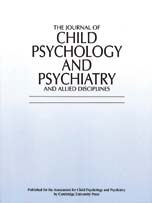Crossref Citations
This article has been cited by the following publications. This list is generated based on data provided by
Crossref.
Mathiesen, Kristin S.
and
Sanson, Ann
2000.
Dimensions of Early Childhood Behavior Problems: Stability and Predictors of Change from 18 to 30 Months.
Journal of Abnormal Child Psychology,
Vol. 28,
Issue. 1,
p.
15.
Keown, Louise J.
Woodward, Lianne J.
and
Field, Jeff
2001.
Language development of pre‐school children born to teenage mothers.
Infant and Child Development,
Vol. 10,
Issue. 3,
p.
129.
Constantino, John N
Cloninger, C.Robert
Clarke, Adrian R
Hashemi, Bahar
and
Przybeck, Thomas
2002.
Application of the seven-factor model of personality to early childhood.
Psychiatry Research,
Vol. 109,
Issue. 3,
p.
229.
Shiner, Rebecca
and
Caspi, Avshalom
2003.
Personality differences in childhood and adolescence: measurement, development, and consequences.
Journal of Child Psychology and Psychiatry,
Vol. 44,
Issue. 1,
p.
2.
Pesonen, Anu-Katriina
Räikkönen, Katri
Keskivaara, Pertti
and
Keltikangas-Järvinen, Liisa
2003.
Difficult temperament in childhood and adulthood: continuity from maternal perceptions to self-ratings over 17 years.
Personality and Individual Differences,
Vol. 34,
Issue. 1,
p.
19.
Hayward, Chris
Wilson, Kimberly A.
Lagle, Kristy
Killen, Joel D.
and
Taylor, C. Barr
2004.
Parent-Reported Predictors of Adolescent Panic Attacks.
Journal of the American Academy of Child & Adolescent Psychiatry,
Vol. 43,
Issue. 5,
p.
613.
Diamond, Karen E.
and
Kontos, Susan
2004.
Families' Resources and Accommodations: Toddlers with Down Syndrome, Cerebral Palsy, and Developmental Delay.
Journal of Early Intervention,
Vol. 26,
Issue. 4,
p.
253.
Goodwin, Renee D.
Fergusson, David M.
and
Horwood, L. John
2004.
Early anxious/withdrawn behaviours predict later internalising disorders.
Journal of Child Psychology and Psychiatry,
Vol. 45,
Issue. 4,
p.
874.
Naerde, Ane
Roysamb, Espen
and
Tambs, Kristian
2004.
Temperament in Adults-Reliability, Stability, and Factor Structure of the EAS Temperament Survey.
Journal of Personality Assessment,
Vol. 82,
Issue. 1,
p.
71.
Weiss, Sandra J.
Jonn‐Seed, Mary St.
and
Wilson, Peggy
2004.
The temperament of pre‐term, low birth weight infants and its potential biological substrates.
Research in Nursing & Health,
Vol. 27,
Issue. 6,
p.
392.
Karp, Jennifer
Serbin, Lisa A.
Stack, Dale M.
and
Schwartzman, Alex E.
2004.
An observational measure of children's behavioural style: Evidence supporting a multi‐method approach to studying temperament.
Infant and Child Development,
Vol. 13,
Issue. 2,
p.
135.
Wilson, Kimberly A.
and
Hayward, Chris
2005.
A prospective evaluation of agoraphobia and depression symptoms following panic attacks in a community sample of adolescents.
Journal of Anxiety Disorders,
Vol. 19,
Issue. 1,
p.
87.
Nakamura-Tani, Toshiaki
2005.
Human personality traits are associated with individual environmental traits in male adolescents—a pilot study.
Comprehensive Psychiatry,
Vol. 46,
Issue. 1,
p.
56.
Carlson, Marcia J.
and
McLanahan, Sara S.
2006.
Strengthening Unmarried Families: Could EnhancingCouple Relationships AlsoImprove Parenting?.
Social Service Review,
Vol. 80,
Issue. 2,
p.
297.
Finzi-Dottan, Ricky
Manor, Iris
and
Tyano, Sam
2006.
ADHD, Temperament, and Parental Style as Predictors of the Child’s Attachment Patterns.
Child Psychiatry and Human Development,
Vol. 37,
Issue. 2,
p.
103.
Mathiesen, Kristin S.
and
Prior, Margot
2006.
The impact of temperament factors and family functioning on resilience processes from infancy to school age.
European Journal of Developmental Psychology,
Vol. 3,
Issue. 4,
p.
357.
Tamás, Zsuzsanna
Kovacs, Maria
Gentzler, Amy L.
Tepper, Ping
Gádoros, Júlia
Kiss, Enikő
Kapornai, Krisztina
and
Vetró, Ágnes
2007.
The Relations of Temperament and Emotion Self-regulation with Suicidal Behaviors in a Clinical Sample of Depressed Children in Hungary.
Journal of Abnormal Child Psychology,
Vol. 35,
Issue. 4,
p.
640.
Fisch, Gene S.
2007.
Animal Models and Human Neuropsychiatric Disorders.
Behavior Genetics,
Vol. 37,
Issue. 1,
p.
1.
SCHATZ, JEFFREY
and
ROBERTS, CARLA W.
2007.
Neurobehavioral impact of sickle cell disease in early childhood.
Journal of the International Neuropsychological Society,
Vol. 13,
Issue. 6,
p.
933.
Rushton, J. Philippe
Bons, Trudy Ann
and
Hur, Yoon-Mi
2008.
The genetics and evolution of the general factor of personality.
Journal of Research in Personality,
Vol. 42,
Issue. 5,
p.
1173.

